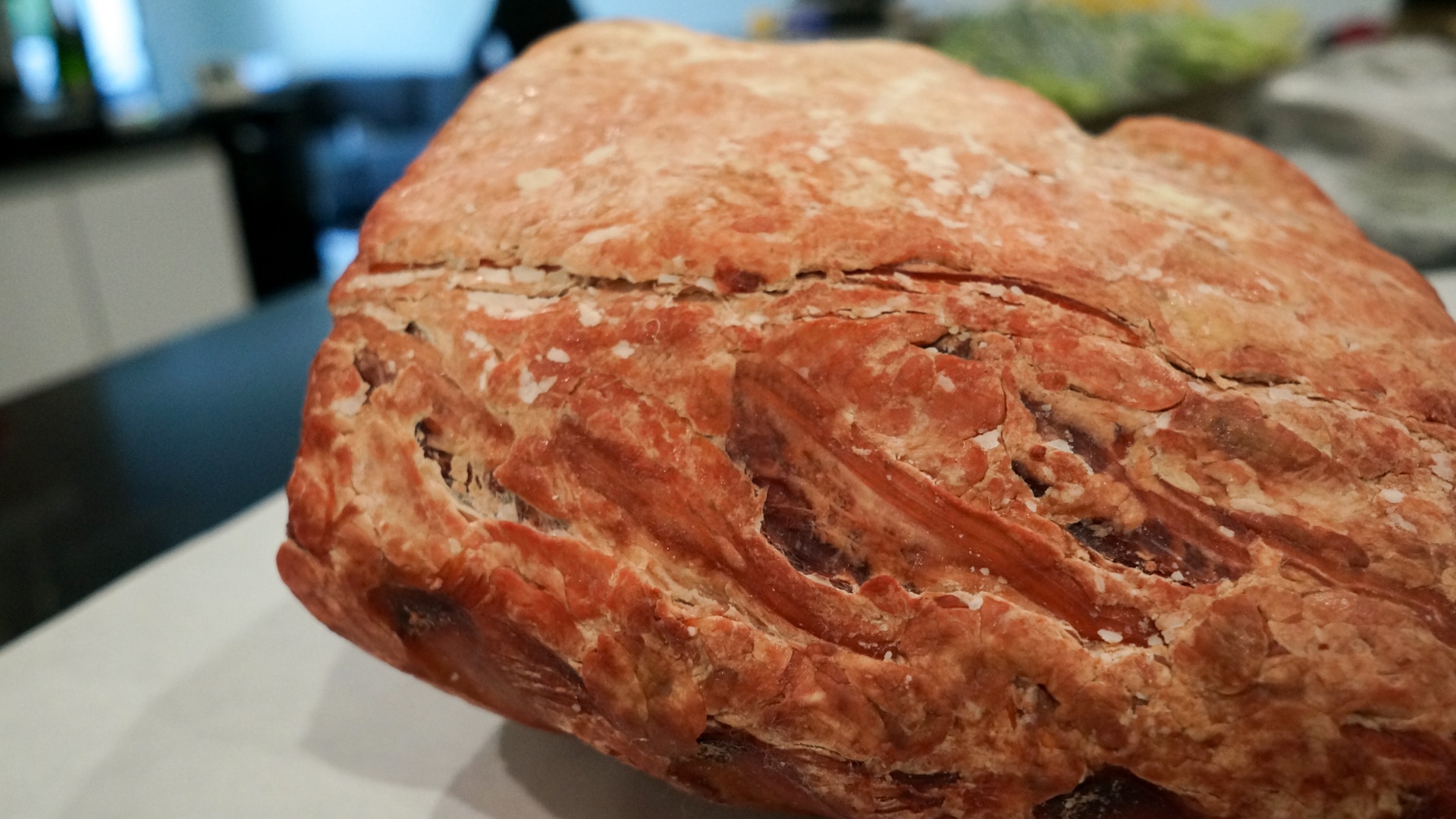Beef is dry aged to make it more tender and flavorful. During dry aging, enzymes in the meat go to work on the connective tissue and muscle fibers, resulting in increased tenderness. Also, a significant amount of moisture evaporates from the meat, resulting in more intense flavor. At the end of this article, I’ve included links to more information about aging meat that you might find interesting.
I was inspired to dry age a standing rib roast after watching Alton Brown do one on Good Eats on the Food Network. Experts like Brown and Cook’s Illustrated magazine say that you can safely dry age beef in your refrigerator at home for 3-7 days, while others like Bruce Aidells suggest that you leave dry aging to professional butchers.
If you choose to dry age a standing rib roast, you accept the risk of ruining an expensive cut of meat, or that you won’t like the resulting flavor. Some people who are not familiar with the taste of dry aged beef describe it as “gamy” or “musty”. Others call it “buttery” or “rich”. In the end, it’s all a matter of personal preference.
In any event, you’ll need to start with a high-quality standing rib roast. You’ll find info on how to choose a good one in the Standing Rib Roast Selection & Preparation article.
Certainly dry-aging your prime rib for six weeks will create a delicious holiday main dish and a pretty good story for the table to boot. But if dry-aging is maybe more commitment than you’re ready for, give Chef John’s Perfect Prime Rib a try.

Dry aging a prime rib is a labor of love that I have to thank my mother for undertaking with me. We bought a beautiful prime rib at the local butcher intending to freeze for a week then eat it for New Year’s Day dinner. But when the sweet little old butcher heard our sacrilegious plan for his beautiful hunk of prime rib he intervened and insisted that we dry age it at home. After a quick primer from the butcher and checking with both Alton Brown and Guy Fieri (he may have strange hair but he has good step-by-step directions for this process) on the web, we began dry aging at home. My mother bravely took custody of the large roast and gave up her fridge to the endeavor. If you are going to spend $100 on meat might as well admire it in your fridge for a week or more while it ages. The smell of aging meat may last longer in your refrigerator than the leftovers but a dry aged prime rib is a really a special meal and worth the effort. We now make one of these roasts at least a few times a year, it is always the favorite dinner of anyone invited to join us.
Three-Rib, Small-End Standing Rib Roast
This is a three-rib USDA Choice standing rib roast cut from the small end (ribs 10-12), weighing 7.73 pounds. It came already tied by the butcher, and I left it that way during aging.
- When buying a bone-in rib roast, figure on 1 to 1-1/4 pounds pre-cooked weight per serving.
- Buy a roast with the rib bones attached. They provide better moisture retention and flavor, act as a natural roasting rack, and are good to eat.
- It’s not necessary for the roast to be tied during dry aging, but it should be tied at each bone before cooking. This prevents the spinalis dorsi muscle, also known as the “rib eye cap”, from separating from the outer edge of the roast during cooking. Tying also keeps the roast in a round shape for more even cooking. Place the roast bone-side down. Cut a length of kitchen twine, loop it around the roast parallel to the first bone, bringing the two ends to the top of the roast. Pull snug and tie with whatever kind of knot you like, then repeat at each bone.
- Don’t bother cutting the ribs off and tying them back on before cooking. They’re easily removed once the roast is cooked.
To learn more about standing rib roasts, see the Standing Rib Roast Selection & Preparation article.
This video demonstrates how to tie a roast. Click on the video to play.
How long should you dry age a steak? 7 RIBEYES go head to head
FAQ
Should I dry my prime rib in the fridge?
How long can you wet age prime rib?
How long can you dry age beef in the refrigerator?
How do you age prime beef?
How to dry age prime rib at home?
To successfully dry age prime rib at home, it is essential to have the right equipment and maintain proper environmental factors. Refrigeration is a key factor in the dry aging process. A dedicated refrigerator, separate from the one used for everyday food storage, is highly recommended.
How long does it take for displaced ribs to heal?
Displaced ribs can be caused by blunt trauma, accidents, falls, cancer, osteoporosis, or severe chest injury. The symptoms of displaced ribs are an abnormal movement of the chest during breathing, severe pain, and tenderness. It usually takes around 4 to 6 weeks for the healing of displaced rib fractures.
What happens when prime rib is dry aged?
When the prime rib is dry aged, it allows the meat to develop a more concentrated flavor and tender texture. To successfully dry age prime rib at home, it is essential to have the right equipment and maintain proper environmental factors. Refrigeration is a key factor in the dry aging process.
What temperature should prime rib be dry aging?
The ideal temperature for dry aging prime rib is between 34 and 38 degrees Fahrenheit (1 to 3 degrees Celsius). Consistent temperature control ensures that the meat ages evenly and minimizes the risk of spoilage. Regularly monitoring the meat during the aging process is essential to ensure its safety and quality.
